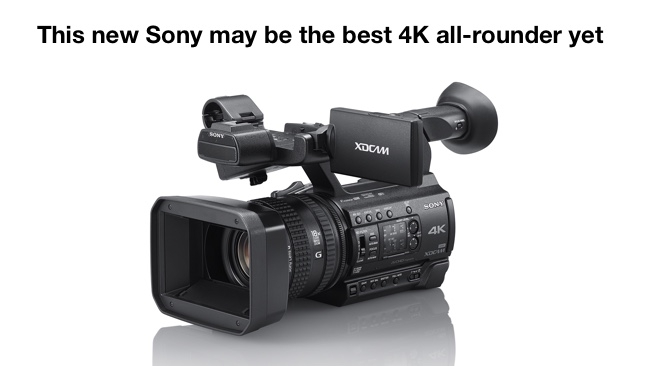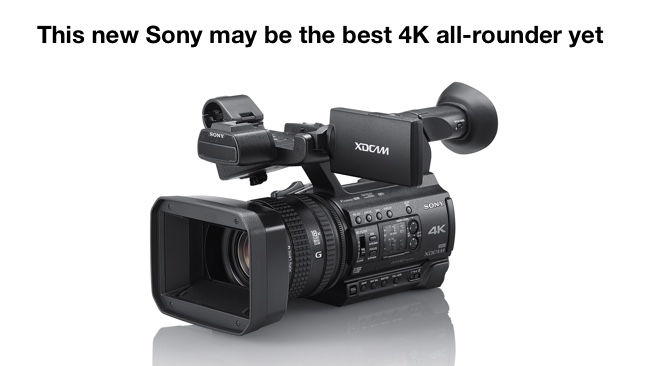

Our 2016 countdown reaches Number 7 and we reckoned that the versatile and extremely capable new 4K Sony PXW-Z150 looked to be just the sort of camera that every camera person wants to have with them at all times.
The Complete Top 10 (based on page views)
1. Nvidia's GTX 1080 Is this the end of Mac-based video production?
2. Five things a Colorist would like to say to a DP
3. Is something dramatic about to happen with Final Cut Pro X?
4. This is how good Canon’s low light camera is
5. Apple could dominate the entire NLE space with the next Final Cut Pro
6. Is Lytro's new 755MP, 300fps cinema camera the biggest leap in video tech ever?
7. Sony's new PXW-Z150: the camera you should always take with you?
8. RED launches not one, but two 8K cameras
9. Sony FS5 Review: How good is Sony's latest large sensor camera?
10. Surprise new Super 8 camera from Kodak
Porsche must be familiar with this problem. How do you promote a product that’s all-new but looks the same as your other products? It’s not Sony's fault. You can’t change the appearance (and hence the form factor) of a camera just to make it different from the one that went before it. If you’ve spent years evolving your product range into what you and your customers consider to be nearly ideal in shape and function, it would be ludicrous to change it into something that isn’t necessarily better just to make it stand out.
So, you can imagine how I felt when I first saw the PXW-Z150 sitting on a table in Sony’s press conference room, prior to the public launch of this new camera. My initial thoughts were that this is a minor release. From a distance it looked the same as all the other Sony XDCAM cameras.
But everything from this point on went to prove how wrong I was, because it its own way, this camera is very important indeed.
For a start, it uses Sony’s Stacked Sensor technology. This is quite different from Sony’s previous 1” type camera , the PXW X70, which is itself a very good performer. Stacked Sensor Technology means that all the processing is in a layer that’s parallel to and close by the light-sensing elements. This makes it fast. While it doesn’t mean that you can film bullets slicing through peaches, it does give you a very useful 120 fps in HD resolution (30 fps max in 4K). And there’s very little rolling shutter, unless you do things to deliberately provoke it. These are things that you mostly wouldn’t do in your everyday work as a video maker.
The new camera shoots in UHD 4K. It records to Sony’s efficient XAVC Long GOP codec up to a maximum of 100 Mbit/s in 4K.
The 1” type sensor is a good size for this type of camera. For a handheld, you definitely don’t want a full frame. That would confine you to world where you have to decide whether someone’s eyelash or the tip of their nose should be in focus, because everything else will be blurred. The sensor is has 14.2 effective pixels and the images are down-sampled from this resolution.
With the 1” sensor, you have some good choices: very deep depth of field for documentary shooting, and a much narrower range for, perhaps, interviews where the camera can be on a tripod.
I saw some images, and they looked detailed, colourful and contrasty. With only an HD monitor to view them on, I couldn’t comment on the ultimate quality, but in HD, the 4K acquired material looked very good indeed.
The pictures were’t particularly cinematic, but that’s not what you’re typically looking for with this type of camera. But what it did give you was some very good “broadcast-like” pictures that I can’t see anyone complaining about. The point is that you can get good, saturated pictures straight out of this camera, without needing complicated log workflows.
If you want to shoot for broadcast there's good old MPEG 2 HD, and a 50 Mbit/s mode which should satisfy most eligibility criteria.
The new camera comes with a Sony “G” lens, which is roughly the equivalent in marketing and build terms of Canon’s “L” glass. These lenses have a “premium” quality, which makes them a good fit for a camera with a fixed lens. I’ve always thought that there’s a very good case for using fixed lenses in lower priced professional camcorders because the lens is always there, you’ll never expose the camera’s innards to dust and grit, and because the camera can will be absolutely designed around the performance of the lens. In other words: everything is optimised around the fixed lens.
The PDX X150’s lens has a very useful 12 x optical zoom. There’s a four-step NDI filter.
The camera has WiFi including NFC for painless pairing. There’s 3G SDI, HDMI and XLR inputs for audio. Battery life is good with an optional larger battery giving four hours recording time.
Recording is to SDXC and SDHC cards. There are some clever touches that make use of the dual media slots. For example, while recording the whole event on one card, you can use a separate button to record (what you expect to be) highlights on another. Relay recording is also possible so that if you plan well, you’ll be able to record events of absolutely any length.
There are some very useful “proxy” modes that you could - at a stretch - use for immediate upload to internet streaming services.
It seems to me that this is a genuinely different and immensely useful addition to the XDCAM range. It’s a rugged, easily portable 4K shooter with good quality glass and which has less need for a plethora of accessories because so much is already built in. the 1” sensor is from Sony’s latest generation of imagers. The camera felt good to me: solid and with enough heft for basic stability, and yet small and portable enough that you can fit it in in the most basic luggage.
For high quality shooting at a very wide range of events, and for documentary and news work, the PXW-Z150 seems like a very good addition to Sony’s range.
You can read Sony’s full press release over the page.
Basingstoke, February 23rd 2016: Sony has today announced the PXW-Z150, the latest addition to its XDCAM range of lightweight, easy to use professional camcorders with new functionality to enable wireless operation and 4K*1 high quality shooting. The flexible, effortless set up capabilities of the portable PXW-Z150 enables content creators of all experience levels to deliver impressive imagery for content and events shooting scenarios, no matter how tight their brief. The PXW-Z150 features a 1.0 type stacked Exmor RS CMOS image sensor, providing users with spectacular 4K recording and impressive 5x slow motion in Full HD - essential functionality for content creators looking to deliver corporate or personal productions to the highest quality.
Go beyond what’s been traditionally possible with a camcorder; catch every moment in up to 120 frames per second (fps) High Frame Rate continuous recording, in full HD quality. The Clear Image Zoom technology operates at 24x zoom and 18x zoom in HD and 4K modes respectively, in addition to the standard optical 12x zoom. The single 20 megapixel*2 1.0 type large sensor size offers clear pictures even in low light, giving filmmakers superb clarity and sharpness, opening up the opportunities for flexible shooting in a variety of environments. In response to rising expectations in the fast paced corporate industry, users can now enjoy live streaming capabilities and FTP wireless connection with built-in Wi-Fi.
Ensuring creative expression isn’t subject to an extensive set up; the PXW-Z150 is ergonomically designed to facilitate shooting with ease. The compact, lightweight body includes integration with advanced features, removing the need for multiple external accessories. The built-in 4-step ND filter is included to offer the flexibility of exposure and depth-of-field control, and the Multi-Interface (MI) Shoe avoids cabling with easy integration between the PXW-Z150 and Sony’s peripherals, such as the UWP-D series wireless microphones. The PXW-Z150 can be easily controlled by a smartphone or tablet using a Wi-Fi remote, and has a battery life which delivers a remarkable 400*3 minutes continuous recording time – allowing you to always be on hand to capture what’s needed. High visibility is delivered with the wide view-angle and high contrast 0.39-type 1440K OLED viewfinder, alongside the 3.5-type 1550K LCD panel.
The PXW-Z150 lends itself to a variety of environments and editing requirements, supporting the conventional broadcasting format MPEG2HD (50Mbps/35Mbps) in addition to Sony’s advanced XAVC format (Long GOP) format. The PXW-Z150 provides a wide variety of built-in connectivity options including professional standard 3G-SDI, XLR inputs, HDMI, USB, REMOTE and Composite (phono), eliminating the need for adapters. To extend recording times and workflow flexibility, the camcorder is equipped with two memory card slots and is compatible with SDXC and SDHC cards. The dual media slots enable various recording options such as backup, simultaneous and relay recording.
“We wanted to introduce a portable camcorder which supports our customers in demanding situations, where there is the need for a solution which provides a quick set-up yet with high quality creative options,” said James Leach, Product Marketing Manager at Sony Professional Solutions Europe. “The compact, lightweight camera body coupled with high quality creative features and 4K capability gives filmmakers the tools needed to take their work to the next level, whether it’s corporate, event or online videography. Clients’ expectations within the creative landscape are constantly evolving and content creators need solutions that can not only provide high quality images, but also deliver this in a timely and professional manner. The effortless set up ensures flexible shooting, while the Wi-Fi integration means you can take advantage of live streaming, ensuring the PXW-Z150 is ready when you are.”
Key features of the PXW-Z150
- 4K high quality shooting with a 1.0-type Exmor RS image sensor and premium G lens
The PXW-Z150 supports: 4K*1 XAVC Long maximum 100Mbps high quality shooting. The 1.0-type Exmor RS image sensor provides high sensitivity and high performance in low light environments. The high-speed read-out ensures high-speed motion shooting with minimum distortion. Videographers can deliver high resolution and contrast from the centre to the edge of the lens, with the high performance 4K-compatible 29-348mm wide-angle lens with 12x optical zoom.
- Use on a wide range of applications with 120fps slow motion, rich recording format and network functions
The camcorder supports full HD 120fps continuous high-speed shooting, which enables 5x slow motion expression. High quality FHD XAVC Long 4:2:2 10bit 50Mbps and the broadcasting format MPEG2HD (50Mbps/35Mbps) are also supported. Users can take advantage of the advanced network functions – such as the camcorder’s built-in Wi-Fi for live streaming capabilities (QoS will be supported by a firmware update) and FTP wireless connections - to integrate wireless workflows, enabling users to keep pace with ever changing client deadlines.
- High operability and rich interface, within a compact and lightweight body
The PXW-Z150 provides extended functionality with 3 independent lens rings, in addition to high visibility with wide view-angle and high contrast 0.39-type 1440K OLED viewfinder and 3.5-type 1550K LCD panel. Sony’s MI Shoe wireless microphone receivers are supported, increasing the mobility and limiting the need for external cables and multiple accessories. The camcorders rich interface includes: 3G-SDI, HDMI, XLR, Cold Shoe and REMOTE. In addition to this, dual media slots facilitate various recording options such as backup, simultaneous and relay recording.
*1 4K (3840x2160) up to 30P is supported
*2 14.2 million effective pixels
*3 Using optional NP-F970 battery while recording XAVC 1080/50i or 60i, 50 Mbps with LCD on.
Tags: Production


Comments